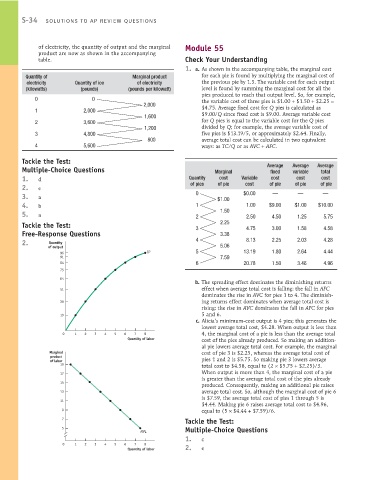Page 880 - Krugmans Economics for AP Text Book_Neat
P. 880
S-34 SOLUTIONS TO AP REVIEW QUESTIONS
of electricity, the quantity of output and the marginal Module 55
product are now as shown in the accompanying
table. Check Your Understanding
1. a. As shown in the accompanying table, the marginal cost
Quantity of Marginal product for each pie is found by multiplying the marginal cost of
electricity Quantity of ice of electricity the previous pie by 1.5. The variable cost for each output
(kilowatts) (pounds) (pounds per kilowatt) level is found by summing the marginal cost for all the
pies produced to reach that output level. So, for example,
0 0 the variable cost of three pies is $1.00 + $1.50 + $2.25 =
2,000
1 2,000 $4.75. Average fixed cost for Q pies is calculated as
1,600 $9.00/Q since fixed cost is $9.00. Average variable cost
2 3,600 for Q pies is equal to the variable cost for the Q pies
1,200 divided by Q; for example, the average variable cost of
3 4,800 five pies is $13.19/5, or approximately $2.64. Finally,
800 average total cost can be calculated in two equivalent
4 5,600 ways: as TC/Q or as AVC + AFC.
Tackle the Test:
Multiple-Choice Questions Marginal Average Average Average
total
variable
fixed
1. d Quantity cost Variable cost cost cost
2. e of pies of pie cost of pie of pie of pie
3. a 0 $1.00 $0.00 — — —
4. b 1 1.00 $9.00 $1.00 $10.00
5. a 2 1.50 2.50 4.50 1.25 5.75
Tackle the Test: 3 2.25 4.75 3.00 1.58 4.58
Free-Response Questions 3.38
2. Quantity 4 8.13 2.25 2.03 4.28
of output 5.06
96 TP 5 13.19 1.80 2.64 4.44
91 7.59
84 6 20.78 1.50 3.46 4.96
75
64
b. The spreading effect dominates the diminishing returns
51 effect when average total cost is falling: the fall in AFC
dominates the rise in AVC for pies 1 to 4. The diminish-
36 ing returns effect dominates when average total cost is
rising: the rise in AVC dominates the fall in AFC for pies
19 5 and 6.
c. Alicia’s minimum-cost output is 4 pies; this generates the
lowest average total cost, $4.28. When output is less than
0 1 2 3 4 5 6 7 8 4, the marginal cost of a pie is less than the average total
Quantity of labor cost of the pies already produced. So making an addition-
al pie lowers average total cost. For example, the marginal
Marginal cost of pie 3 is $2.25, whereas the average total cost of
product
of labor pies 1 and 2 is $5.75. So making pie 3 lowers average
19 total cost to $4.58, equal to (2 × $5.75 + $2.25)/3.
17 When output is more than 4, the marginal cost of a pie
is greater than the average total cost of the pies already
15
produced. Consequently, making an additional pie raises
13 average total cost. So, although the marginal cost of pie 6
is $7.59, the average total cost of pies 1 through 5 is
11
$4.44. Making pie 6 raises average total cost to $4.96,
9 equal to (5 × $4.44 + $7.59)/6.
7 Tackle the Test:
5 Multiple-Choice Questions
MPL
1. c
0 1 2 3 4 5 6 7 8
Quantity of labor 2. e

